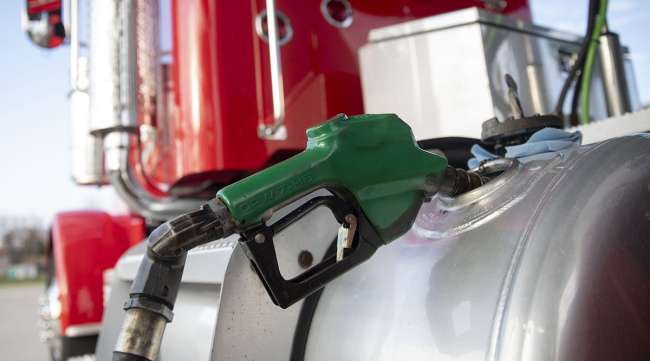Senior Reporter
Diesel Price’s Virtual Holding Pattern Continues

[Stay on top of transportation news: Get TTNews in your inbox.]
For the second week in a row, the price of diesel remained essentially flat compared with the prior week, dipping just one-tenth of a cent to $2.426 a gallon, the Energy Information Administration reported Aug. 24.
In the past six weeks, diesel has decreased five times and increased once. The price continues to move in a very narrow range between $2.41 and $2.43 a gallon.
Gasoline showed a price increase nationally and in every region, bumping up 1.6 cents overall to hit $2.182, which is still 39.2 cents cheaper than a year ago.
The price of diesel was down in five of the 10 regions the EIA surveys. It was up in four regions, and it remained flat in one.
With the decrease, the nationwide price of trucking’s primary fuel is 55.7 cents a gallon less than it was a year ago.

Natural gas and propane join electric power as alternatives to diesel. Host Seth Clevenger talks with Chad Lindholm of Clean Energy and Stuart Weidie of Alliance Autogas. Hear a snippet, above, and get the full program by going to RoadSigns.TTNews.com.
The biggest decline was in the New England region, where the price fell by seven-tenths of a cent to $2.62 a gallon.
The price of diesel increased four-tenths of a cent in the Rocky Mountain region to $2.369 a gallon. Still, the price there is 56.7 cents a gallon less expensive than it was a year ago.
The most expensive diesel in the nation is in California, where the price climbed one-tenth of a cent to $3.265. There, the price of diesel is 62.2 cents less expensive than it was a year ago.
The least expensive fuel is in the Gulf Coast region, where the price of diesel fell three-tenths of a cent to $2.174 a gallon. That’s 57 cents less expensive than it was a year ago.
The Gulf Coast boasts the lowest price in part because it is home to much of the country’s oil and gasoline production and a large share of the refining capacity.
However, that production could be in jeopardy, at least temporarily, because of Hurricane Laura, which came ashore Aug. 27 near Cameron, La., as a Category 4 storm.
The Interior Department’s Bureau of Safety and Environmental Enforcement, which is the lead agency for the safety and environmental protection relating to the offshore energy industry, said 84% of Gulf oil production and 61% of natural gas production is shut down because of Laura.
“After the storms have passed, facilities will be inspected,” the agency said. “Once all standard checks have been completed, production from undamaged facilities will be brought back online immediately.”
Nearly 300 production platforms have also been evacuated due to Laura and the prior storm in the Gulf, Marco.
The workers on those platforms typically return to work in a matter of days, and during tropical storms or hurricanes, the impact on production is usually short-lived.
Hurricane Laura struck land with 150 mph winds in an area that accounts for 45% of all U.S. petroleum refining capacity and 17% of oil production, according to the EIA.
“Hurricane Laura packed a wallop,” Chicago-based energy Price Futures Group analyst Phil Flynn told Transport Topics. “The strongest hurricane in 168 years and already there are signs that the U.S. energy industry is trying to make strides to get back to normal, yet we are just starting to assess the damage.”
The price of West Texas Intermediate crude oil, the industry’s benchmark, continues to trade in a very narrow range, closing Aug. 24 at $42.20 a barrel. The price has barely moved in the last month, and it’s down 37.1% compared to a year ago when it was $65.65 a barrel.
Hours after Hurricane Laura hit, WTI was down 46 cents, or 1.1%, at $42.93 a barrel on the New York Mercantile Exchange.
Widespread flash flooding along small streams, urban areas, and roadways will continue across portions of Louisiana, Mississippi, and Arkansas. #Laura pic.twitter.com/Z66sPA9A44 — National Hurricane Center (@NHC_Atlantic) August 27, 2020
American Trucking Associations Energy and Environmental Affairs Counsel Glen Kedzie told TT there will be a temporary reduction in oil and gas production, which will likely increase the price of diesel and gasoline in the coming weeks.
“The oil companies are going to have to secure any offshore drilling, which means it’s going to cut off production until this hurricane passes. It could put some short-term reductions in refining capacity, especially if they’re damaged,” Kedzie said. “They’re used to hurricanes in the Gulf, but things can become unpredictable. If you follow traditional patterns, there could be some justification by the oil companies to increase prices.”
Kedzie said it’s been a tough year for the energy industry, with steep declines since March through August, in diesel and gasoline usage because of the COVID-19 pandemic.
“They’re still hurting with losses in revenue from COVID, and they’ll be looking to pick up nickels and dimes wherever they can.”
Kedzie did say there is an abundance of oil in storage at facilities across the country, because of the drop-off caused by the coronavirus, but it still could take weeks to get that product refined if refineries are damaged by Hurricane Laura.
Subscribe: Apple Podcasts | Spotify | Amazon Alexa | Google Assistant | More




